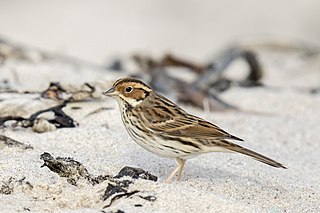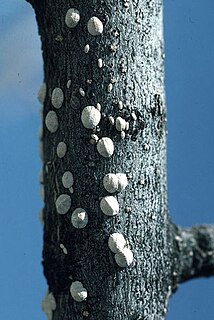Related Research Articles

Alder is the common name of a genus of flowering plants, Alnus, belonging to the birch family Betulaceae. The genus comprises about 35 species of monoecious trees and shrubs, a few reaching a large size, distributed throughout the north temperate zone with a few species extending into Central America, as well as the northern and southern Andes.

The little bunting is a passerine bird belonging to the bunting family (Emberizidae).

The Mymarommatidae, sometimes referred to as False fairy wasps. are a very small family of microscopic hymenopteran insects. Only about half of the known species are living taxa, but they are known from all parts of the world. Undoubtedly, many more await discovery, as they are easily overlooked and difficult to study due to their extremely small size.

A forest steppe is a temperate-climate ecotone and habitat type composed of grassland interspersed with areas of woodland or forest.

Petaurista is a genus of rodent in the family Sciuridae. They are large to very large flying squirrels found in forests and other wooded habitats in southern and eastern Asia.
Paleontology or palaeontology is the study of prehistoric life forms on Earth through the examination of plant and animal fossils. This includes the study of body fossils, tracks (ichnites), burrows, cast-off parts, fossilised feces (coprolites), palynomorphs and chemical residues. Because humans have encountered fossils for millennia, paleontology has a long history both before and after becoming formalized as a science. This article records significant discoveries and events related to paleontology that occurred or were published in the year 1964.

Diaspididae is the largest family of scale insects with over 2650 described species in around 400 genera. As with all scale insects, the female produces a waxy protective scale beneath which it feeds on its host plant. Diaspidid scales are far more substantial than those of most other families, incorporating the exuviae from the first two nymphal instars and sometimes faecal matter and fragments of the host plant. These can be complex and extremely waterproof structures rather resembling a suit of armor. For this reason these insects are commonly referred to as armored scale insects. As it is so robust and firmly attached to the host plant, the scale often persists long after the insect has died.

Lecanodiaspididae is a family of scale insects commonly known as false pit scales or lecanodiaspidids. Members of this family come from all parts of the world but are most numerous in the Far East.
Cretorhyssalus is an extinct genus of wasps which existed in what is now Russia during the Cenomanian age of the Late Cretaceous. It was described by Sergey A. Belokobylskij, and contains the species C. brevis.
Magadanobracon is an extinct genus of wasps which existed in what is now Russia during the Cenomanian age. It was described by Sergey A. Belokobylskij, and contains the species M. rasnitsyni and M. zherikhini.

The Armenian cochineal, also known as the Ararat cochineal or Ararat scale, is a scale insect indigenous to the Ararat plain and Aras (Araks) River valley in the Armenian Highlands. It was formerly used to produce an eponymous crimson carmine dyestuff known in Armenia as vordan karmir and historically in Persia as kirmiz. The species is critically endangered within Armenia.

Spathius galinae is a parasitoid of emerald ash borer. The known range of S. galinae extends from the Russian Far East to South Korea. It is currently approved for release in some areas of North America as part of a biological control program against emerald ash borer.
Pavel Iustinovich Marikovsky was a Russian entomologist, arachnologist, and popular science author known for his research in ants and the insect fauna of Kazakhstan and Central Asia, as well as over 60 popular science books, which made him one of the most popular science promoters of the former Soviet Union. His 1954 monograph Tarantula and Karakurt is still used by zoologists, and his most popular general science books include For the Young Entomologist, In Talas Alatau and Across the Semirechye. He served in the Great Patriotic War, earning several honors including Order of the Red Star, Order of the Patriotic War, and Order of the Badge of Honour.

Xylota abiens is a European species of hoverfly.
Dirrhope is the only extant genus in the subfamily Dirrhopinae of braconid parasitoid wasps. Dirrope was included in the Microgastrinae until 1984. Specimens of this genus have been found fossilsed in amber dating from the Cretaceous period.

Colastes is a genus of braconid wasps in the family Braconidae. There are at least 80 described species in Colastes.
Microtachycines is a genus of cave or camel crickets in the subfamily Aemodogryllinae and tribe Aemodogryllini. The type species name M. tamdaonensis is based on specimens found in Tam Dao National Park in Vietnam.
Tamdaotettix is a genus of cave or camel crickets in the subfamily Aemodogryllinae and tribe Diestramimini. Originating in Asia, species have been found in the Indo-China region.
Megadiestramima is a genus of cave or camel crickets in the subfamily Aemodogryllinae and tribe Diestramimini. Originating in Asia, species have been found in the Indo-China region.
Aspilota is a genus of insect from the Braconidae family.
References
- ↑ Belokobylskij, S.A.; Tobias, V.I. (2007) Alysiinae. (in Russian), In: A.S. Lelej (ed.) 'Key to the insects of Russia Far East. Vol.IV. Neuropteroidea, Mecoptera, Hymenoptera. Pt 5.' Vladivostok: Dalnauka. 1052 pp. pp.9-133.